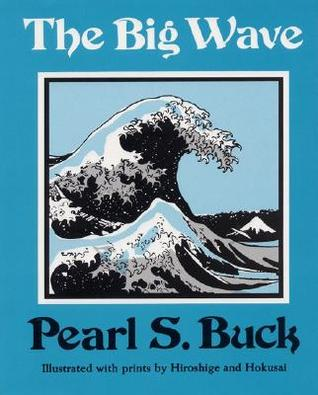The Big Wave : A Damn Good Book
The Big Wave is a fictional book by Pearl S. Buck, an American novelist.
Before we dive into the story, a bit about the author. Ms. Buck was the first
American woman to win the Nobel Prize in Literature in 1938. She was also
awarded the Pulitzer prize in 1932 for her book The Good Earth.
I’ll quickly explain the setup and the main conflict of the novel. It is about
a boy named Kino, who lives on an island in Japan, which is between a volcano
and the ocean. His parents are farmers, and they own land on a hill. Kino has no
worries in life, as he wakes up to a beautiful view of the ocean, and goes to
play for most of the day. He loves to run on the beach and swim near
the ocean. One day he meets a boy named Jiya. Jiya’s father is a fisherman, and
he says that the ocean is an enemy. Kino is flabbergasted by this, as he finds
the ocean beautiful, and odd that of all people saying the ocean is their
enemy, it is a fisherman. Kino and Jiya become friends, and spend most of their
time together. One day, they swim to an island filled with sacred deer. They
play with the deer and collect pebbles. Soon, they swim back to the shore as
the sun sets. Jiya’s dad was extremely worried, as this was the latest Jiya has
ever come back home. The next day, the ocean is much more violent than usual.
The same day, the volcano on the other side of the island produces plumes of
smoke. Seeing this, Kino gets scared, and asks his dad if they are going to
die. His father says, “Fear alone makes man weak. If you are afraid, your hands
tremble, your feet falter, and your brain cannot tell your hands and feet what
to do.” As Jiya lives all the way down the hill, near the shore, not
able to come to play, Kino gets very bored. As the storm worsens, Kino’s and
Jiya’s friendship will be tested, and you can find the outcome by reading the
book yourself.
The inspiration for this book was that the author, Pearl S. Buck
lived in Japan during her life. She lived on a hillside above the ocean, just
like Kino. When she was writing this book, she wanted to illuminate the culture
of Japan. She felt the best way to do this along with her writing was by
including Japanese art. I totally agree with her choice, because every 5 to 10
pages, there is a beautiful piece of art which correlates with the plot. It was
refreshing to take a break from all the words and just admire the creativity of
the paintings by the great Japanese artists Hiroshige and Hokusai.
It wasn’t just the art that stuck with me, but also one of
the major themes of the book that really startled me and challenged my
thinking. Like the storm in the book, places like Japan and California and
Indonesia always seem to have natural disasters, but population and tourism are
still at an all-time high in these regions. It has always mystified me why
people still choose to live and visit these regions. This book gives us a
glimpse into why some disaster prone areas are inhabited, saying “‘To live in
the midst of danger is to know how good life is’. … ‘To live in the presence of
death makes us brave and strong. That is why our people never fear death’. …
‘To die a little later or a little sooner does not matter. But to live bravely,
to love life, to see how beautiful the trees are and the mountains, yes, even
the sea, to enjoy work because it produces food for life - in these things we
Japanese are a fortunate people.’” When I consider these statements, it makes
me realize that everyone who is living accepts some risks. An example is when
you get in a car or go on a plane, there is always a chance that something
might go wrong, but we live with it, as we think the pros outweigh the cons.
I personally enjoyed this book much more than I expected. My aunt
gave it to me over winter break, telling me that this was a book that she read
in her school days. It seems like a little children’s book at first, and by no
means am I saying that this is a tough read. But the experience itself was
otherworldly. I would totally recommend this book to anyone, as it is a fun and
enjoyable read. And on that bombshell, it's time to end. Goodbye.
- Sri



Hi Sri! This review was amazing! I really like how you mentioned that this book seemed like it would be for children when you first started reading it, but it turned out to be so much more complex than what you expected. This book sounds super interesting, and I will be sure to check it out soon!
ReplyDeleteI've also wondered why people would willingly choose to live in these places. I think that the quotes got me thinking a bit differently. Also, I've never thought about how it could be similar to our every day lives.
ReplyDeleteReading your summary of the book reminded me of the movie: Moana, although the plot in this book sounds a little more interesting. The art in the book looked beautiful, and I wish that more books would do that. I don't think it makes a book 'childish' and I don't think it takes anything away from the quality of the literature by putting images in a book.
ReplyDelete